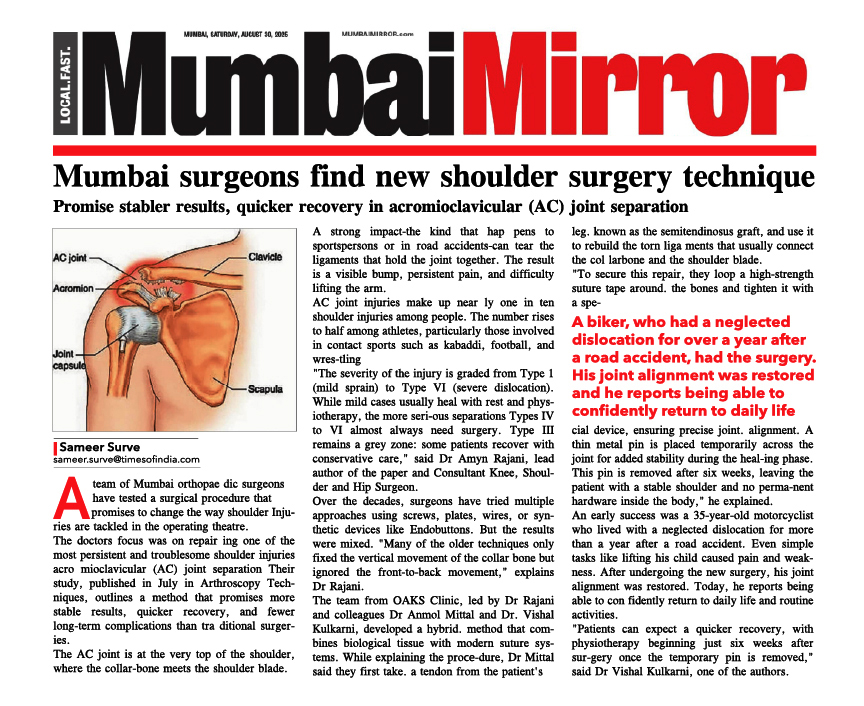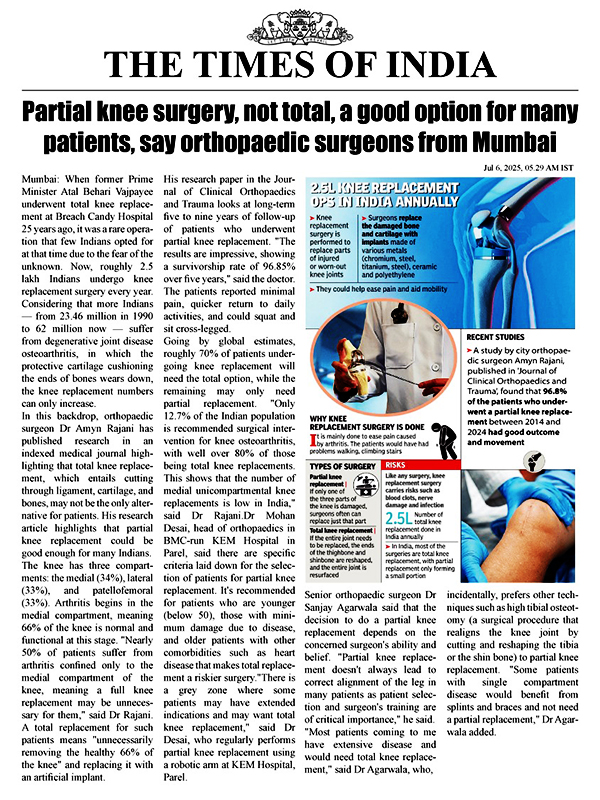When considering a Total Knee Replacement (TKR), most patients look forward to a life free from chronic pain and stiffness. While TKR is one of the most successful orthopedic procedures, a small percentage of patients may encounter a specific and frustrating complication known as "patellar clunk."
The term "clunk" perfectly describes the issue: a palpable and often audible clunking or catching sensation at the front of the knee as it moves from a bent position to a straight one. This can be unsettling and sometimes painful, leading to patient dissatisfaction. If you or a loved one are experiencing this issue after a Total Knee Replacement, it's essential to understand its causes, symptoms, and the best course of action with an experienced knee specialist in Mumbai like Dr. Amyn Rajani.
What is Patellar Clunk Syndrome?
Patellar Clunk Syndrome (PCS) is a post-operative complication that can occur after Total Knee Replacement, specifically with a type of implant called a "posterior-stabilized" knee prosthesis. This type of implant features an internal cam and post mechanism designed to replicate the function of the knee's natural posterior cruciate ligament (PCL).
The "clunk" is caused by the formation of a fibrous nodule—essentially a small knot of scar tissue—on the undersurface of the quadriceps tendon, just above the kneecap (patella). As the knee bends, this nodule can get caught in the intercondylar notch (the box-like opening) of the femoral component of the implant. When the knee straightens, the nodule snaps free from this box, creating the characteristic "clunk" sound and feeling.
Why Does Patellar Clunk Happen?
The development of Patellar Clunk Syndrome is not a sign of surgical failure but rather a specific type of scar tissue formation. The primary factors contributing to its occurrence are:
- Implant Design: The condition is almost exclusively associated with posterior-stabilized knee implants. While these designs are excellent for stability, their specific geometry can predispose some patients to the formation and impingement of scar tissue.
- Fibrous Nodule Formation: The body's natural healing response to surgery involves forming scar tissue. In some cases, this tissue can accumulate at the tendon-implant interface, creating the fibrous nodule that causes the clunk.
- Patient Anatomy and Movement: Individual patient factors, such as the position of the kneecap and the way it tracks during knee flexion and extension, can also play a role.
It's important to note that the incidence of PCS has significantly decreased over the years due to advancements in implant design and surgical techniques. However, it is still a recognized complication that requires specialized attention.
Recognizing the Symptoms: When to See a Specialist
If you've recently undergone a TKR, it's normal to have some clicking or creaking sounds as your knee heals. However, a patellar "clunk" is distinct and usually presents with the following symptoms:
- A Painful, Audible "Clunk" or "Catch": This is the hallmark symptom. The sound and sensation are most prominent when the knee is extended from a bent position (typically around 30-45 degrees of flexion).
- Anterior Knee Pain: Pain is localized to the front of the knee, often accompanying the clunking sensation. This can be especially noticeable when rising from a chair or climbing stairs.
- Difficulty with Activities of Daily Living: The catching and pain can make simple activities, such as walking or standing, feel unstable and uncomfortable.
If you are experiencing these symptoms, it is crucial not to ignore them. Early diagnosis and treatment can prevent further discomfort and potential complications. You need to consult a specialized knee surgeon in Mumbai with a deep understanding of knee replacement complications.
The Importance of a Specialized Approach: The Role of Dr. Amyn Rajani
Treating Patellar Clunk Syndrome requires a surgeon with a high level of expertise in total knee replacement and its potential complications. Dr. Amyn Rajani is a leading joint replacement surgeon in Mumbai who has extensive experience in diagnosing and treating complex post-operative issues.
Here's how a specialist like Dr. Rajani approaches this condition:
- Accurate Diagnosis: The first step is to confirm that the clunk is indeed Patellar Clunk Syndrome and not another issue, such as implant loosening or infection. A thorough physical examination and advanced imaging like MRI can help identify the fibrous nodule.
- Conservative Management: In some mild cases, physical therapy focused on quadriceps strengthening and patellar mobilization may help alleviate symptoms. However, for a true patellar clunk caused by a significant fibrous nodule, this is rarely a permanent solution.
- Surgical Intervention (Arthroscopic Debridement): The definitive treatment for Patellar Clunk Syndrome is a minor surgical procedure called arthroscopic debridement. This is a minimally invasive surgery where the surgeon, using a small camera and instruments, enters the knee joint to resect (remove) the fibrous nodule. The procedure is quick, effective, and has a high success rate.
Dr. Amyn Rajani's expertise is particularly valuable here. As the best robotic knee replacement surgeon in Mumbai, he has a precise understanding of the intricate mechanics of knee implants. His experience with both traditional and robotic techniques allows him to accurately assess the underlying cause of the clunk and perform the corrective procedure with the highest degree of precision.
Why Choose a Robotic Knee Replacement Surgeon?
The advent of robotic technology in knee replacement has significantly reduced the risk of complications like patellar clunk. Robotic systems allow for meticulous pre-operative planning and intra-operative precision, ensuring that the implant is placed with perfect alignment, which minimizes the chance of soft tissue impingement.
While a clunk can still occur, a surgeon who is an expert in this technology, like Dr. Amyn Rajani, is exceptionally qualified to manage it. Their knowledge of knee biomechanics and implant design goes far beyond the standard, enabling them to offer the most advanced solutions.
The Path to Recovery: What to Expect After Treatment
The recovery from an arthroscopic debridement for Patellar Clunk Syndrome is typically much faster than the initial TKR. Patients can expect to regain their full range of motion and be free of the clunking sensation. Physical therapy for Patellar Clunk Syndrome will be recommended to ensure proper knee function and muscle strength.
Don't Live with Discomfort: Schedule an Appointment
A Total Knee Replacement is meant to improve your quality of life. If a patellar clunk is holding you back, it's time to seek expert help. Living with a painful or annoying clunk is not a necessary consequence of TKR.
As the best knee replacement surgeon in Mumbai, Dr. Amyn Rajani and his team are dedicated to providing comprehensive care, from initial diagnosis to post-operative follow-up. If you are experiencing any unsettling symptoms after your knee replacement, don't hesitate to reach out.
Schedule a consultation with a leading knee specialist in Mumbai to get a definitive diagnosis and a personalized treatment plan. Let Dr. Amyn Rajani help you achieve the pain-free, active life you were promised by your knee replacement.





